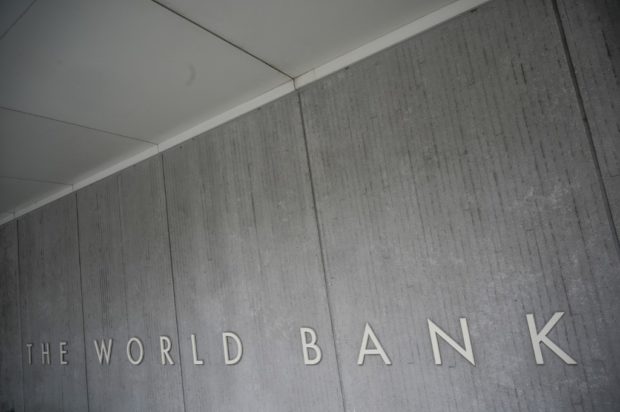PH faces steeper climb to Marcos Jr.’s upper middle-income goal as WB further hikes threshold

The World Bank Group logo is seen on the building of the Washington-based global development lender in Washington on January 17, 2019. (FILE photo by Eric BARADAT / AFP)
MANILA, Philippines — With the World Bank raising its threshold each year, President Ferdinand Marcos Jr. and his economic team’s goal for the Philippines to achieve upper-middle income status like its more developed neighbors may take time, although beneficial to concessional borrowings in the near term.
The latest World Bank data released on July 1 showed the Philippines’ gross national income (GNI) per capita rose to $3,640 in 2021, from $3,430 in 2020 at the height of its worst annual recession post-war. GNI refers to the total income generated by a country’s residents within and outside its borders, unlike gross domestic product (GDP) — a proxy for economic performance — which measures only local output.
However, the Philippines’ latest GNI per capita still fell short of the Washington-based multilateral lender’s new GNI per capita threshold of $4,256-13,205 for upper-middle income countries, which was upped from $4,096-12,695 last year.
As such, the Philippines remained a lower-middle income economy in the World Bank’s classification for this fiscal year, unable to join China, Malaysia and Thailand among upper-middle income countries.
Just like the Philippines, Indonesia (with GNI per capita of $4,140 last year) and Vietnam ($3,560) stayed as lower-middle income economies, where GNI per capita ranged between $1,086 and $4,255, up from last year’s $1,046-4,095.
The Philippines’ GNI per capita in 2021 also remained below the $3,850 it achieved in 2019, as its 2020 economic performance reversed the upward trend prior to the COVID-19 pandemic.
This year, Belize moved up to upper-middle income, while Panama and Romania became high-income economies with GNI per capita of over $13,205. On the flip side, Palau slid from high income last year to upper-middle income; Lebanon dropped to lower-middle income from upper-middle income; and Zambia fell to low income from lower-middle income.
Last week, Finance Secretary Benjamin Diokno said the Marcos Jr. administration aimed to end its term in 2028 with the Philippines an upper-middle income country, having a single-digit poverty incidence rate as well as a narrower budget deficit and lower public debt ratio close to pre-pandemic levels.
In May, former socioeconomic planning secretary Karl Kendrick Chua said the Philippines was poised to move up to upper-middle income status next year if the economy grew by the then targeted 7-9 percent this year. However, former president Rodrigo Duterte’s economic team later on tempered this year’s growth expectations to a narrower 7-8 percent mainly due to external risks such as the prolonged Russian invasion of Ukraine which spills over locally through elevated food and oil prices, supersized interest rate hikes in the US, as well as a slowing Chinese economy.
Early this year, Chua was still optimistic of climbing to upper-middle income status, but later conceded that 2023 may be the more realistic goal given that many overseas Filipino workers (OFWs), who contribute to the country’s GNI, have yet to resume their work.
Had the pandemic not happened, the Philippines was slated to graduate from lower-middle income economy status in 2020, ahead of the Duterte administration’s 2022 target.
But if the Philippines became an upper-middle income economy two years ago, it would have lost this year the access to low interest rates currently slapped on official development assistance (ODA) loans extended by its bilateral and development partners as well as by multilateral lenders like the World Bank, the Manila-based Asian Development Bank (ADB), and the China-led Asian Infrastructure Investment Bank (AIIB). A total of $2 billion in low-interest loans from the World Bank, the ADB, and the AIIB financed the purchase of the bulk of the Philippines’ COVID-19 vaccines and booster shots.
As such, staying as a lower-middle income country augured well to the Philippines’ borrowing spree amid the prolonged fight against the pandemic.
But for think tank IBON Foundation, the ascent to upper-middle income status was “just a number; even if reached, this is an empty achievement amid the weakest economy and worst joblessness in decades and will just reflect the prosperity of an elite few.”
“Even if the Philippines meets the requisite minimum [for upper-middle income], this will be while agriculture and manufacturing are treading their lowest shares of the economy in over 70 years,” IBON said back in February.
“That so-called upper-middle income status is incongruous while millions of Filipinos suffer joblessness or poor-quality work,” IBON said, adding that “this widespread joblessness is driving poverty.”
“There are some 18 million poor and vulnerable families nationwide with low incomes and no savings. The government is trying to hide or at least distract from this reality by hyping the Philippines about to become an upper-middle income country,” according to IBON.
For IBON, “increasing GNI per capita is not benefiting ordinary Filipinos because the gains are concentrated in a few families and their corporations… The net worth of the top 40 richest Filipinos grew from the equivalent of 13 percent of GDP in 2006 to 20 percent in 2021, indicating a worsening concentration of economic power; this includes their wealth jumping 30 percent in 2021 amid growing poverty and unemployment.”
